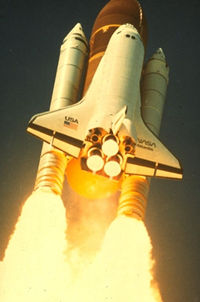Energy Pages:
 Photosynthesis Intro
Page
Photosynthesis Intro
Page
 Energy Flows Through Life
Energy Flows Through Life
Other FT Exploring Pages
 Dr
Galapagos Dr
Galapagos
 What
is an Engineer, Really What
is an Engineer, Really
 Site Map Site Map
 Link
Pages Link
Pages
 Lesson Plans
Lesson Plans
 Contact
Us Contact
Us
|
|
| |
Power
- How Fast is Your Energy Being Converted?
| |
|

|
|
| |
|
|
The space shuttle's power
at takeoff is about 11,000,000,000 Watts, or 11 Giga Watts (GW), or 11,000,000,000
Joules of energy being converted from stored chemical energy to kinetic energy
and thermal energy every second.
Eleven Giga Watts is the same as 14.75 million horsepower, or 10,424,048 BTU's
of chemical energy converting to kinetic energy each second.
|
|
 |
 |
 |
 |
 |
Confused about the
difference between power and energy?
I don't mean the kind of power politicians crave. I'm talking about the kind of
power related to energy that you learn about in physics.
In physics,
power and energy do go hand in hand, but they're not the same thing. Whenever
energy is changing or moving, there also is power, telling us how fast the energy
is being transformed.
Energy, as described in other pages on this site, is the property of matter that
makes things happen. To make things happen, energy must change form or change
locations. Power is a measure of how fast those energy changes are happening.
Energy comes in set quantities like Joules (1 Newton-meter), foot-pounds, Calories,
or BTU's (British Thermal Units).
Power is a rate. In physics, rates describe how something changes with time.
For example, velocity is the well known rate of distance traveled per length of
time. If we measured Superman running 5000 kilometers (km) in 5 seconds of time,
we could say Superman's velocity was 5000 kilometers (km) per 5 seconds (s).
Then you might say, "Well Wonder Woman just ran 6400 km in 7 seconds".
Who's faster?
To make it more consistent for comparisons, we like to keep our time units as
1, so we could divide 5000 km by 5 seconds. Now we can say Superman runs "1000
kilometers per 1 second" (5000 km/5 s), or just 1000 km/s. Wonder Woman only
runs 914.3 km/s (6400/7). Maybe she was just jogging.
Power is the rate of energy change per length of time. It tells us the quantity
of energy that changed during a certain period of time. So the units of power
are chunks of energy per amount of time, like 1 Joule per second (which is the
same as 1 Watt), or 1000 Btu per hour, or 550 foot-pounds of energy per second
(which is 1 horsepower).
Light Bulbs, Heaters, & Watts:
As we just said above, the unit of power called a Watt is the measure of energy
being converted at the rate of 1 Joule every second. A 50 Watt light bulb converts
50 Joules of electrical energy to thermal energy (heat)
and electromagnetic radiation (light) every second.
A 100 Watt light bulb converts 100 Joules every second, mostly to heat and a little
light also. Yes, it's true, a typical incandescent bulb is mostly making heat.
That's why it's so hot to touch. Only about 2 percent of the electical energy
being converted in a light bulb becomes light. The other 98% is making heat that
warms up the air in your house. Not so bad in the winter, but definitely unwanted
on a hot summer day.
| |
|
|
Units
of Energy & Power
An important and useful
measure of energy is the Joule (J).
A Joule is officially the amount of energy required to exert a force of 1 Newton
through a distance of 1 meter. So one Joule equals 1 Newton-meter
or 1 N-m (1 J = 1 N-m).
That's the mechanical definition. Thermal energy can also be defined, as we show
a couple of paragraphs below.
A Joule is not a lot of energy, unless you're a hummingbird. A hummingbird in
flight converts 1 Joule of energy to heat, kinetic energy, and aerodynamic lift,
every second. That means the little bird requires about 1 Watt (1 J/s) of power
to fly.
Energy units like Btu's and calories are generally defined in terms of thermal
energy. A Btu is approximately the amount of energy needed to increase the thermal
energy of 1 pound of water enough to raise it's temperature by 1 degree Farenheit.
A calorie is the amount of energy needed to raise the temperature of 1 gram of
water by 1 degree celsius. The Calories that dieters worry about, are really kilocalories
(kcal) or 1000 calories. In other words the amount of energy required to increase
the temperature of 1 kilogram (1000 grams) of water by 1 degree C.
One Btu is equivalent to about 1055 Joules. The kilocalories that weight watchers
count are equal to 4,186 Joules.
|
|
 |
 |
 |
 |
 |
How about that small
electric heater in your family room. It sucks up 1500 Watts of power
on the highest setting. That means it is converting 1500 Joules of electric energy
directly into thermal energy every second. Pretty much the same thing that fifteen
100-Watt incandescent bulbs are doing.
Lifting Weights:
On earth it
takes about 10 Newton-meters (N-m) of energy to raise a 1 kilogram mass to a height
of 1 meter. Since 1 N-m equals 1 Joule, that's 10 Joules. If it takes 1 second
to lift the weight 1 meter, than you have converted 10 Joules of energy to potential
energy in one second. That's 10 Watts of power. If you lift a 2 kg weight 1 meter
in 1 second, then the rate of energy conversion is 2 x 10 = 20 Joules per second,
or 20 Watts of power.
If you can keep lifting a 1 kg weight to a height of 1 meter every second, weight
after weight after weight, then you will be steadily producing 10 Watts of power.
Your arm would get tired after a while.
Let's slow down. Suppose you move the 1 kilogram weight more slowly so that it
takes 2 seconds to lift it 1 meter. Now the rate of work is 10 Joules (Newton-meters)
of energy every 2 seconds. Ten Joules divided by 2 seconds is 5 Joules per second,
or 5 Watts. Remember that 1 Watt is equal to 1 joule of energy conversion every
second.
Power in a Locomotive
On a more dramatic scale, a locomotive is a device designed to convert the chemical
potential energy stored in diesel fuel into the kinetic energy of thousands of
tons of freight, and itself, moving down the track.
 |
|
|
| |
Modern
locomotives in the US range from about 4000 to 6000 horsepower. One horsepower
is equal to about 746 Joules of energy conversion per second ( 746 Watts). |
|
|
|
 |
 |
 |
 |
 |
A typical gallon of
diesel fuel stores about 130,000 Btu's (more than 137 million Joules) of chemical
energy.
If the diesel engine of a 6000 horsepower (4476 kilowatts) locomotive has a thermal
efficiency of 42% (pretty good), then it will burn about 280 gallons of fuel every
hour. Almost 30 million Btu's of stored chemical energy are being converted into
thermal energy and kinetic energy every hour.
( As the 2nd law of themodynamics
tells us, each of those little concentrated gallons of useful energy are now lost
to us forever. The First Law tells
us the energy is still around, but after being turned into useful kinetic energy
of the moving train, the energy, all of the energy, through friction, becomes
low-grade thermal energy that simply can't be reused. The useful high-grade energy,
formerly stored in the fuel, is gone and we'll never get it back.)
Human Power
 How
much power do we humans generate going about our daily activities? How
much power do we humans generate going about our daily activities?
Let's take a man about my size. I weigh about 75 kg (165 pounds) of solid muscle.
Okay, stop laughing, there's some fat in there. Anyway someone like me, just sitting
around (a good way to add more fat) reading or watching TV (a stupid waste of
time compared to reading, if you're determined to add fat), converts about 68
Calories of food energy into heat and bodily functions (pumping blood, breathing,
cellular processes, etc.) every hour. That's equal to about 79 Watts of power,
just to sit and stay alive. Me and the 75 Watt bulb are both heating up the room
at about the same rate (but the light bulb is brightening things up a bit).
If I get off my duff and start walking briskly, say 3.5 miles per hour, then I
am converting about 330 Calories of food energy to motion and thermal energy every
hour. That's about 383 Watts of power. Pretty good, huh? Watch the fat melting
away. Keep walking every day, and it really will.
Now, if I really get motivated and start jogging at a pretty good clip, but not
quite a full out sprint, I might manage to convert 642 Calories of energy into
motion and heat every hour (though it is doubtful I could keep up that pace for
an hour). Now I am generating 745 Watts of power, or 745 Newton-meters (Joules)
of energy every second. That's almost 1 horsepower! Forget about it. I can't do
that.
Say It Again
Power is the rate at which energy is converted. Whenever energy changes form,
or moves from place to place (heat flow), the rate at which it makes those changes
is described as power. If a device converts one Joule of energy every second the
power is 1 Watt. If a device converts one Joule of energy every 10 seconds, the
power is one tenth of a Watt (1 J/10 seconds = 0.1 Watts). If a device converts
1000 Joules of energy every second, the power is 1000 Joules per second, or 1000
Watts (1 kilowatt).
The Watt is a unit of power that is equal to one Joule of energy being converted
every second. Power is always some unit of energy (like Joules, foot-pounds, Btu's,
calories) divided by some unit of time (like seconds, minutes, hours, or months).
One Btu per month is a very small unit of power.
|
|
| |
Back
to the Energy Intro Page
|
|
| |
If this page was helpful, please recommend:
|
|
 |
 |
 |
|
|
|

